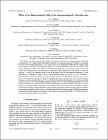| dc.contributor.author | COFFEY, WILLIAM THOMAS | |
| dc.contributor.author | KALYMYKOV, YURI PETROVICH | |
| dc.date.accessioned | 2009-06-18T09:52:12Z | |
| dc.date.available | 2009-06-18T09:52:12Z | |
| dc.date.issued | 1995 | |
| dc.date.submitted | 1995 | en |
| dc.identifier.citation | Coffey, W.T., Crothers, D.S.F., Dormann, J.L., Geoghegan, L.J., Kalmykov, Yu.P., Waldron, J.T., Wickstead, A.W., 'Effect of an oblique magnetic field on the superparamagnetic relaxation time' in Physical Review B - Condensed Matter and Materials Physics, 52, 22, (1995), pp 15951-15965 | en |
| dc.identifier.other | Y | |
| dc.identifier.uri | http://hdl.handle.net/2262/30627 | |
| dc.description | PUBLISHED | en |
| dc.description.abstract | The effect of a constant magnetic field, applied at an angle to the easy axis of magnetization, on the Neel relaxation time of a single domain ferromagnetic particle (with uniaxial anisotropy) is studied by calculating the lowest nonvanishing eigenvalue 1 (the escape rate) of the appropriate Fokker-Planck equation using matrix methods. The effect is investigated by plotting 1 versus the anisotropy parameter for various values of and the ratio h=2, where is the external field parameter and 1 versus for various h values (for rotation of the magnetization vector M both in a plane and in three dimensions). If M rotates in a plane the curve of 1 versus is symmetric about =4 in the range 0<<2 and significant decrease in with increasing is predicted for large and. The maximum decrease in occurs at =4 whereupon increases again to the =0 value at =2. For rotation of M in three dimensions, the curve of 1 versus (0<<) is symmetric about =2. Thus the maximum decrease in again occurs at =4 with maximum increase to a value exceeding that at =0 (i.e., with the field applied along the polar axis with that axis taken as the easy axis), at =2 (field applied along the equator), the =0 value being again attained at =. The results are shown to be consistent with the behavior predicted by the Kramers theory of the rate of escape of particles over potential barriers. This theory when applied to the potential barriers for the equatorial orientation of the field for rotation in three dimensions yields a simple approximate formula for the escape rate which is in reasonable agreement with the exact 1 calculated from the Fokker-Planck equation. Pfeiffer's approximate formula for the barrier height as a function of [H. Pfeiffer, Phys. Status Solidi 122, 377 (1990)] is shown to be in reasonable agreement with our results. ? 1995 The American Physical Society. | en |
| dc.format.extent | 15951-15965 | en |
| dc.format.extent | 2006243 bytes | |
| dc.format.mimetype | application/pdf | |
| dc.language.iso | en | en |
| dc.publisher | American Physical Society | en |
| dc.relation.ispartofseries | Physical Review B - Condensed Matter and Materials Physics | en |
| dc.relation.ispartofseries | 52 | en |
| dc.relation.ispartofseries | 22 | en |
| dc.rights | Y | en |
| dc.subject | Condensed matter physics | |
| dc.title | Effect of an oblique magnetic field on the superparamagnetic relaxation time | en |
| dc.type | Journal Article | en |
| dc.type.supercollection | scholarly_publications | en |
| dc.type.supercollection | refereed_publications | en |
| dc.identifier.peoplefinderurl | http://people.tcd.ie/wcoffey | |




